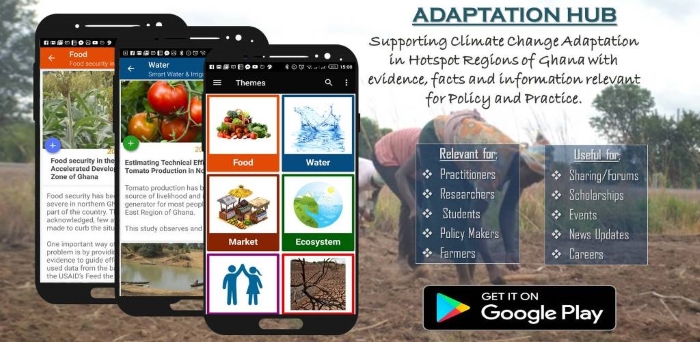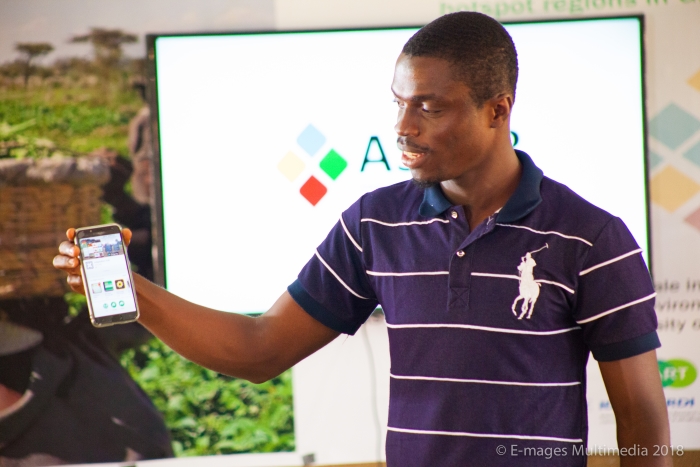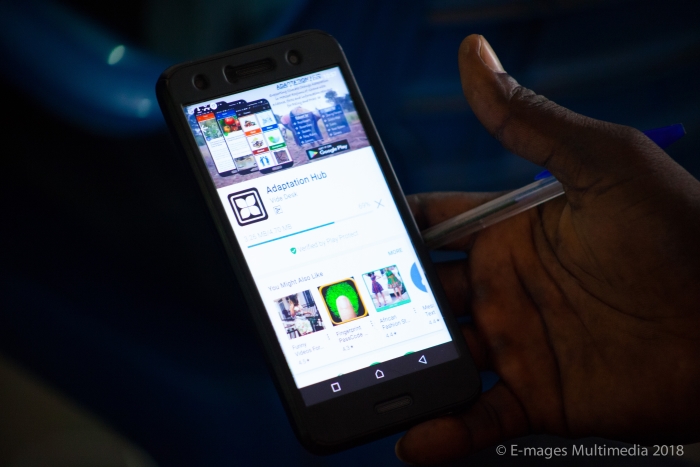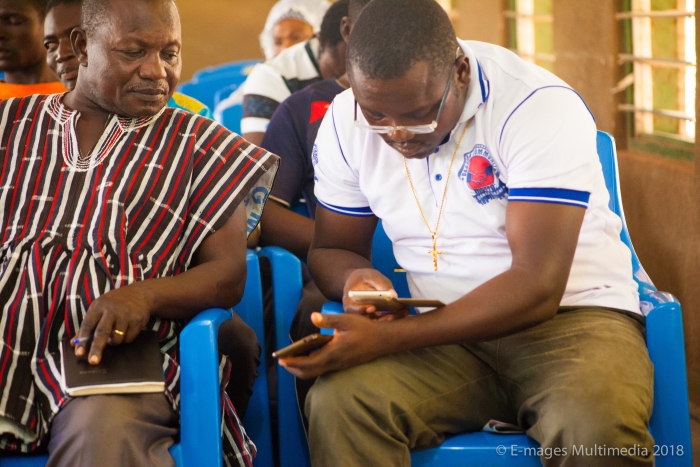Adaptation Hub: using mobile apps to support agriculture and adaptation planning in semi-arid Ghana

By Prince Ansah
Climate change adaptation starts with vulnerable groups receiving accurate and reliable information to plan and make informed decisions on their livelihoods. Transferring research information from knowledge generators and brokers to final users can sometimes be challenging, especially at the local level. Exploring the opportunities within the information communication technology (ICT) space can be pivotal in closing the information gap between knowledge generators and final users. Information is regularly being accessed on smartphones, more so than on any other device, making it the centrepiece for modern communication technology innovations.

Adaptation Hub display banner. (Designed by Prince Ansah)
In Ghana, the use of smartphones has increased by almost 120% over the past few years, prompting one of the highest smartphone penetration rates in Africa. Over one third of Ghana’s population are considered to be active internet users, making it easier to access information via mobile applications.

Demonstrating the use of Adaptation Hub to local stakeholders in Nandom district.
Through the Transformative Scenario Planning (TSP) activities in Upper West region of Ghana, stakeholders developed strategies that could affect agriculture productivity and food security by 2035. During this process, the ASSAR team was urged to disseminate research and other information related to these strategies (smart water management, sustainable food and livelihood, disaster risk reduction, market systems and ecosystem management) to broader stakeholders in the region involved in various development initiatives.
Furthermore, local stakeholders revealed that while research findings can be beneficial to NGOs and government institutions in the region for planning, they are not easily accessible for use due to limited communication channels. ASSAR research findings on the institutional role in adaptation also suggests that research institutions do little or nothing to transfer research findings back to local stakeholders.

ASSAR TSP process in Upper West region, Ghana.
The ASSAR team decided to take advantage of the strong smartphone penetration rate in Ghana by developing a native mobile application that supports information transfer and knowledge sharing with local stakeholders. The team received initial funding through an ASSAR Small Opportunities Grant (SOG) to kick-start this project. The Adaptation Hub mobile app was developed with the objective of building the capacity of extension officers, community development workers, researchers and students in Northern Ghana (Upper West, Upper East and Northern regions). It was decided that farmers would not be made the primary target group, since many of them would have difficulty to access the information, due to illiteracy and the inability to access and use internet services. The large number of stakeholders working with farmers is more likely to be literate and familiar with internet and smartphone use and, as such, can maximise mobile application use.

A stakeholder downloading Adaptation Hub mobile app.
The development phase of the app involved partners from both private and government sectors who supported the building and reviewing of its content. VideDesk, a mobile application start-up, worked on the technical components of the app, while institutions such as the Ministry of Food and Agriculture, planning offices of district assemblies in Nandom and Lawra, the Nandom Dinery Integrated Rural Development Partners (NANDIRDEP), and the Climate Change Office of UNDP, Accra, provided supported with content and the setting up of reviews. Here is what one of the partners had to say about the process:
“Working on this project has given me the opportunity to work outside my comfort zone as a mobile app developer, which is more business oriented. It’s the first time that I am doing a project like this, and for me it’s a great feeling to use my skill set to support an environmental and development-oriented project." – Director, VideDesk
Before launching the app, selected stakeholders at the local and national levels were given the opportunity to test the application and give feedback to improve the services it offers. The app has received praise from different stakeholders, including the operations and assistant director of NANDIRDEP (a local NGO):
“This mobile application is a first-of-a-kind information platform for development workers like us to access research information conducted by a research project in this area. Due to the nature of our work where we move from community to community, we don’t need to look for a computer before we get the information we need to support our farmers. We can now conveniently access it on our phones." – Director of Operations, NANDIRDEP

Stakeholders exploring the mobile app.
This initiative has inspired other ASSAR countries, such as Namibia, to consider developing their own mobile application platform to support their research dissemination and stakeholder engagement efforts in the country and beyond. The team was also contacted by UNDP Ghana to support the development of a proposal to develop an online platform that supports youth employment by connecting the young entrepreneurs to green business opportunities in Ghana.
Adaptation Hub is available on Google Play Store for download. The team is looking forward to adding extra content and further updates to the app, including resources for its maintenance and sustainability for the next two or three years.